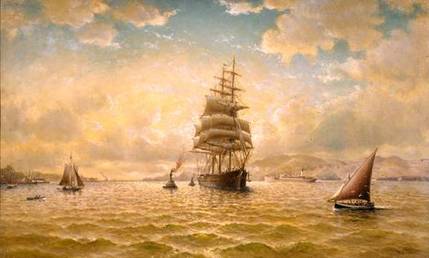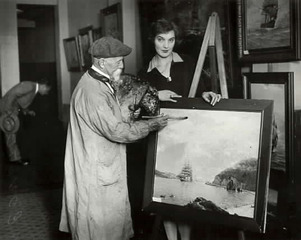 The Paul and Linda Kahn Foundation History, Education, the Arts & Religion
The Paul and Linda Kahn Foundation History, Education, the Arts & Religion
 The Paul and Linda Kahn Foundation History, Education, the Arts & Religion
The Paul and Linda Kahn Foundation History, Education, the Arts & Religion

William F. Babcock Entering San Francisco
HISTORICAL OVERVIEW: The prolific body of paintings and historical drawings created by William A. Coulter (1849-1936) is indelibly woven into the maritime history and development of San Francisco Bay. The life of this pivotal painter of ships and the sea was intertwined from its outset with the events that led to San Francisco's emergence as one of the world's premier centers of maritime activity. The timing of Coulter's birth occurred between two significant voyages, one in sail and one in steam, that began the massive ship migrations that shifted a major portion of the world's maritime endeavor to San Francisco and the new American west.
On March 7, 1849, the day the artist was born in County Antrim, Ireland the side-wheel steamer CALIFORNIA, credited with being first to arrive carrying passengers to the newly discovered gold fields, had been lying off the San Francisco waterfront for less than a week. Her arrival on February 28 marked the first regularly scheduled passenger service between New York and San Francisco. The steamer had departed New York on October 6, prior to the official announcement of the gold discovery. Upon reaching Panama, after a transit of Cape Horn, the vessel was greeted by a mob of gold seekers demanding passage north.
Two weeks after Coulter's birth, the March 20 arrival of the fast sailing bark JOHN W. CATER from New York after a 154 day passage, celebrated the first gold-rush sailing vessel to make the voyage around Cape Horn in response to the news of the gold strikes. Soon vessels from all over the world followed. While William Coulter was growing up in Ireland, the Pacific Coast's maritime commerce was developing in parallel half a world away. When these two forces met, the joining was well made.
Coulter arrived in San Francisco in 1869. After a seven-year career at sea, the 20-year old was forced to move ashore after sustaining a serious injury to his ankle. At almost exactly the same time, whether by co-incidence or fate, the final spike had just been driven at Promontory Point, Utah completing the trans-continental railroad. With its western terminus in Oakland, the Union Pacific became a major factor in precipitating the inevitable decline of the maritime world that had been so instrumental in shaping Coulter's life.
For the next sixty-seven years William Coulter would artistically immortalize the commerce of the Bay and the myriad vessels that represented its golden era of maritime prominence. His years at sea infused his ship paintings with an attention to detail that was remarkable. Unlike most West Coast artists of his period who would add the occasional impression of a sailing ship to provide atmosphere in their work, Coulter's paintings are portraits of immediately recognizable, specific vessels infused with a seaman's awareness of the lead and purpose of every rigging line and the functional aspects of ship form and construction.
Throughout the expansive history of American marine painting, the rich visual documentation of the nation's Pacific coast, for the most part, was overlooked. During the 19th century only three West Coast maritime specialists of any note emerged, but unlike his older contemporaries Gideon Jacques Denny and Joseph Lee, William Coulter created the consummate seafarer's view of the ships and harbors that were so instrumental in the growth of America's Pacific frontier.

While growing up in Ireland, Coulter may have encountered works by pier-head painters working in Belfast such as Joseph Semple and William McIlveny. However, while Coulter's accuracy in depicting the elusive technical facets of a sailing ship was based largely on extensive sea experience, it is obvious that his artistic vocabulary was strongly influenced by exposure to the early Liverpool ship portraitists who first popularized the genre of narrative marine painting. As a British seaman during the 1860's, Coulter would have often visited the maritime Mecca of Liverpool with its thriving school of marine artists.
As with the Liverpool artists, Coulter primarily painted ships in identifiable locations. The Liverpool ship portraits are noted for their repeated backgrounds showing the approaches to Liverpool Harbor. Classic views depict ships off Anglesy's South Stack, Skerries Reef and Light, and the River Mersey with its distinctive Perch Rock Fort and Lighthouse. Coulter favored a similar approach using the same familiar San Francisco backgrounds for his compositions.
Numerous Coulter views show vessels taking aboard a pilot off the Farallons, passing Point Bonita, or entering the Golden Gate off Fort Point. His compositions inside the Bay feature inspiring views of the City Front and to the north showing Alcatraz, Angel Island, Sausalito and Mount Tamalpais as prominent backdrops.
The very nature of Coulter's paintings captured some of the most significant moments in San Francisco's maritime history. For a dozen years spanning the turn of the century, as waterfront artist for the San Francisco Call newspaper, Coulter produced a remarkable output of photographic quality pen and ink sketches documenting the final days of the great 19th century sailing ships and the rapid proliferation of steam vessels.
Ironically, in what is considered his most significant historical work, showing the aftermath of the devastating April 1906 San Francisco earthquake, Coulter captured first-hand the destruction of the Call building, along with much of downtown San Francisco, from a spectacular vantage point off the city's waterfront. This event ended his career as a waterfront reporter and at the same time etched his place in history with a dramatic panoramic work, created on a 5' x 10' window shade he found in the still smoldering ruins. This painting is widely identified as the most accurate on-site, overall representation of California's most famous disaster.
William Coulter continued to paint into the mid-1930's. At age 85 he mounted the final exhibition of his lifetime, presenting 75 marine canvases, all painted after his 80th birthday. His passing on March 13, 1936, five days into his 87th year, closed the door on one of the most extraordinary careers in the world of narrative marine painting. As it was at his birth, his death was bracketed by two significant maritime events. Three months earlier, San Francisco had inaugurated the first Trans Pacific airline service. In less than a year both the Bay and the Golden Gate Bridges would open, dramatically launching a new era in maritime commerce for San Francisco, and helping to close the one William Coulter had so eloquently portrayed.

INTERPRETIVE PLAN: William Coulter's story is at once the story of San Francisco, its Bay and the maritime endeavor that was so necessary in making California both a state and an international center for ocean commerce. It is the story of ships and harbors, triumph and disaster and the growth of the American west coast. It is also the story of a talented immigrant Irish seafarer and his realization of the American dream.
History has given Coulter's paintings an aspect of appreciation he never intended. New meanings and significance emerge as time passes. Coulter painted the ships he knew and loved as they were gradually disappearing from the world's oceans. Today of course, almost all are gone and many are remembered only as a result of Coulter's unique visual chronicle.
Aside from portraying one of the world's truly gifted marine-painters, the exhibit will celebrate the life of an immigrant square-rig sailor, sail-maker, musician, art-student and waterfront reporter who was also a loving husband and father.
The exhibition seeks to enrich the visitor with new insights and greater understanding of the art of William Coulter, a fun-loving Irishman who captured the world's maritime endeavor through eyes that were noted for combining a merry twinkle with the precision of a skilled artistic draftsman.